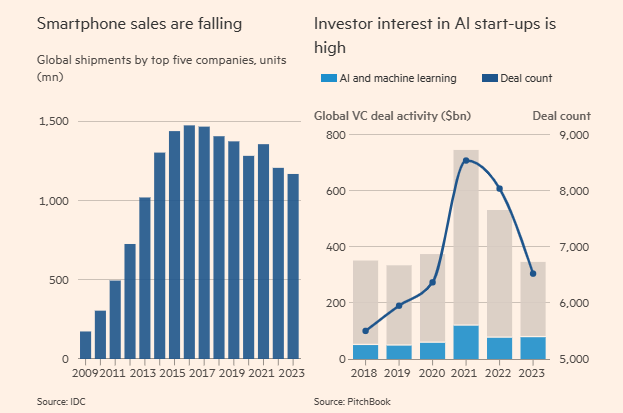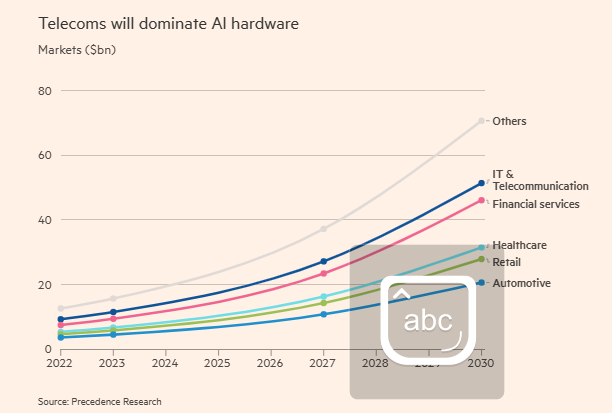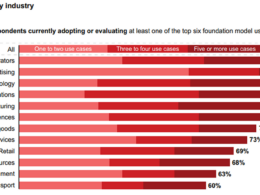the health strategist
institute, portal & consulting
for workforce health & economic prosperity
Joaquim Cardoso MSc.
Servant Leader, Chief Research & Strategy Officer (CRSO),
Editor in Chief and Senior Advisor
19 de janeiro de 2024
This is an Executive Summary of the article “The latest AI gadget frenzy wants to do away with phones”, written by Roula Khalaf, and published on the Financial Times.
What is the message?
There is a growing trend in the consumer tech market where new AI-powered devices, particularly those positioned as smartphone replacements, are gaining attention.
The article discusses the emergence of products like Rabbit’s R1 and Humane’s AI lapel pin, highlighting their features, market potential, and the challenges they face in competition with established smartphone manufacturers.
It also emphasizes the impact of AI integration on traditional smartphone sales and the strategies both startups and industry leaders are adopting in response to this evolving trend.
Ultimately, the article suggests that while there is a significant opportunity for AI gadgets, competition, proximity to existing technologies, and the swift adaptation of established players could shape the future of this emerging market.
One page Summary
The consumer tech landscape is experiencing a surge in AI-powered devices, and the focal point of this phenomenon is the attempt to redefine the role of smartphones.
In the article “The Latest AI Gadget Frenzy Wants to Do Away with Phones,” Roula Khalaf explores the emergence of cutting-edge products like Rabbit’s R1 and Humane’s AI lapel pin, both aiming to revolutionize user experiences and challenge the traditional dominance of smartphones.
- Rabbit’s R1, a $199 “pocket companion,” has gained considerable attention, boasting over 40,000 pre-order sales. The device, described as a new generation compared to conventional phones, features a “large action model” trained on existing interfaces.
- Meanwhile, Humane, a San Francisco startup founded by former Apple employees, has raised over $100 million for its AI lapel pin, priced at $699 with a $24 per month subscription. However, recent layoffs at Humane raise questions about the product’s market reception.
The article underscores the challenges faced by traditional smartphones, which have been slow to integrate generative AI features, contributing to a 3% decline in unit sales in 2023.

With shipments hitting a decade low at 1.17 billion, the article suggests that the potential market value of half a billion dollars could be unlocked if AI gadgets captured just 0.1% of global smartphone sales.
Despite the promising market potential, established smartphone manufacturers are not willing to cede ground.
The proximity of AI gadgets to existing technologies, such as voice activation and music playback, poses a challenge for startups like Rabbit and Humane.
Moreover, consultancy Precedence Research anticipates telecoms to be the largest market for AI hardware, but the article warns that smartphone giants may thwart newcomers’ entry by incorporating AI features into their handsets promptly.
Venture capital’s keen interest in AI, with nearly $80 billion invested in the past year, indicates the allure of this sector.
However, the article suggests that investors should exercise caution, considering the challenges faced by AI gadget startups and the rapid adaptation of AI features by established players like Samsung and Apple.
In conclusion, the article paints a dynamic picture of the consumer tech market, where the race to integrate AI into gadgets is reshaping the industry.
While startups strive to challenge the smartphone status quo, they face hurdles in differentiation and market adoption.
The evolving landscape calls for strategic approaches, continuous innovation, and careful consideration from both startups and investors alike.
Key Points and Arguments:
- AI Gadget Frenzy: The consumer tech market is currently witnessing an influx of AI-powered devices, with many claiming to be smartphone replacements.
- R1 Pocket Companion: Rabbit’s R1, a $199 AI “pocket companion,” has garnered attention, boasting over 40,000 pre-order sales. The device aims to redefine the user experience with a “large action model” trained on existing interfaces.
- Smartphone Market Challenges: Traditional smartphones have faced challenges in integrating generative AI features, leading to a decline in unit sales by 3% in 2023, with total shipments at a decade low of 1.17 billion.
- Market Potential: AI gadgets capturing just 0.1% of global smartphone sales could create a market worth half a billion dollars. However, established smartphone manufacturers are determined to prevent such a shift.
- Venture Capital Investment: AI remains a lucrative area for venture capital, with nearly $80 billion invested in AI and machine learning in the past year, accounting for 23% of all deals.
AI remains a lucrative area for venture capital, with nearly $80 billion invested in AI and machine learning in the past year, accounting for 23% of all deals.
- Humane’s AI Lapel Pin: San Francisco startup Humane, backed by over $100 million in funding, offers an AI lapel pin at a premium price point. However, recent layoffs suggest potential challenges in pre-order numbers.
- Proximity to Existing Devices: The weakness of R1 and Humane’s products lies in their proximity to existing devices, as features like voice activation, making calls, and listening to music already exist in mainstream smartphones.
- Telecoms Market Potential: Consultancy Precedence Research anticipates the telecoms market to be the largest for AI hardware, presenting an opportunity for startups. However, established smartphone companies may thwart their entry.
- Samsung and Apple Competition: Samsung has recently announced AI-enabled features for new phones, while Apple is expected to integrate AI models soon, indicating that established players are adapting quickly to the AI hardware trend.
Conclusions and Recommendations:
- Market Dynamics: The AI gadget frenzy reflects a dynamic shift in consumer preferences, emphasizing the need for innovation in smartphone features.
- Competition Challenges: Startups like Rabbit and Humane face challenges due to the proximity of their products to existing devices. They must differentiate themselves to capture market share.
- Telecoms Market Entry: While the telecoms market presents a substantial opportunity for AI hardware, startups should be wary of competition from established smartphone companies and strategize accordingly.
- Strategic Partnerships: Collaboration with established players or focusing on unique selling propositions can enhance the competitiveness of AI gadget startups.
- Investor Caution: Investors should exercise caution and closely monitor the market response to AI gadget startups, considering the potential risks associated with their proximity to existing technologies.
- Continuous Innovation: To stay relevant, both startups and established players should prioritize continuous innovation and integration of AI features to meet evolving consumer demands.
In conclusion, the intersection of AI and consumer tech presents both opportunities and challenges, requiring a strategic and innovative approach to navigate the evolving landscape successfully.













